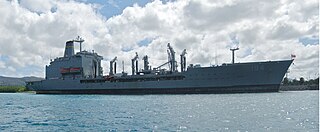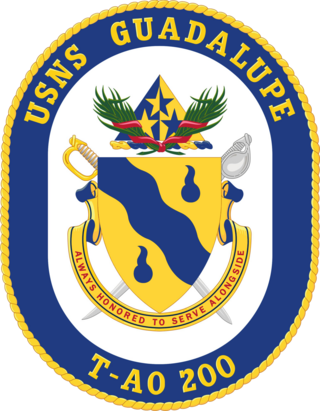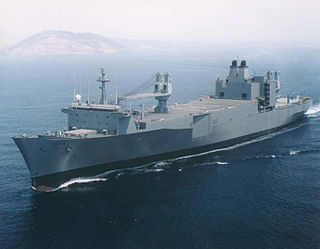
USNS Bob Hope (T-AKR-300), the lead ship of its class of vehicle cargo ships for United States Army vehicle prepositioning, was a naval ship of the United States named after Bob Hope, the entertainer. Very few ships of the United States Navy have been named after a person who was alive at the time of the christening.

The Military Sealift Command (MSC) is an organization that controls the replenishment and military transport ships of the United States Navy. Military Sealift Command has the responsibility for providing sealift and ocean transportation for all US military services as well as for other government agencies. It first came into existence on 9 July 1949 when the Military Sea Transportation Service (MSTS) became solely responsible for the Department of Defense's ocean transport needs. The MSTS was renamed the Military Sealift Command in 1970.

USNS John Ericsson (T-AO-194) is a Henry J. Kaiser-class underway replenishment oiler operated by the Military Sealift Command to support ships of the United States Navy.

USNS Guadalupe (T-AO-200) is a Henry J. Kaiser-class underway replenishment oiler operated by the Military Sealift Command to support ships of the United States Navy.

The Algol-class vehicle cargo ships, also known as Fast Sealift Ships (FSS) or SL-7s, are currently the fastest conventional steam powered cargo ships in the world that are still (intermittently) operating, capable of speeds in excess of 33 knots (61 km/h).. Although in reality both are laid up due to their high operating costs and less than green credentials in terms of fuel burned in transporting one unit of cargo per nautical miles traveled. Originally built in 1972 and 1973 as high-speed container ships known as SL-7s for SeaLand, the ships' high operating costs limited their profitability. All eight ships were acquired by the United States Navy in 1981 and 1982, with the last ship converted, delivered to and placed in service with Military Sealift Command in 1986. The conversion entailed the installation of four cranes, addition of roll on/roll off capability and a redesign of the cargo hold to better facilitate storage of vehicles. Due largely to their high cost of operation, all fast sealift ships are kept in Reduced Operating Status, but can be activated and ready to sail in 96 hours. All ships are named after bright stars in the night sky.

Prevail (IX-537) is a modified Stalwart-class auxiliary general ocean surveillance ship (AGOS) of the United States Navy previously operated by the U.S. Military Sealift Command as T-AGOS 8. Prevail was reclassified as Unclassified Miscellaneous (IX) in October 2003 and is unofficially referred to as TSV-1. In this context, TSV stands for Training Support Vessel, and should not be confused with the U.S. Army's USAV Spearhead Theater Support Vessel initiative.

MV Shughart (T-AKR-295) is the lead ship of her class of cargo ships operated by the United States Navy. She is a 'roll-on roll-off' non-combat vessel designated as a "Large, Medium-Speed Roll-on/Roll-off" (LMSR) ship.

USNS Tippecanoe (T-AO-199) is a Henry J. Kaiser-class underway replenishment oiler operated by the Military Sealift Command (MSC) to support ships of the United States Navy. She serves in the United States Pacific Fleet. Tippecanoe, the thirteenth ship of the Henry J. Kaiser class, was laid down at Avondale Shipyard, Inc., at New Orleans, Louisiana, on 19 November 1990 and launched on 16 May 1992. She entered non-commissioned U.S. Navy service under the control of the MSC with a primarily civilian crew on 8 February 1993.

USNS GySgt Fred W. Stockham (T-AK-3017) is a Shughart-class container & roll-on roll-off support vessel in the United States Navy's Military Sealift Command (MSC). The vessel is the second Navy ship named after Marine Gunnery Sergeant Fred W. Stockham (1881–1918), who was posthumously awarded the Medal of Honor during World War I.

USNS Soderman (T-AKR-317) is a Large, Medium-Speed Roll-on/Roll-off Ship (LMSR) and is part of the Military Sealift Command. The USNS Soderman is in the Preposition Program which stations ships across the world with military equipment. The Soderman is Watson-class vehicle cargo ship built by National Steel and Shipbuilding Company. The ship was launched on April 26, 2002 and put into service on the 24 of September 2002. The ship was named after Private First Class William A. Soderman, a Medal of Honor Recipient for World War II.

USNS Leroy Grumman (T-AO-195) is a Henry J. Kaiser-class replenishment oiler of the United States Navy.

USNS Patuxent (T-AO-201) is a Henry J. Kaiser-class underway replenishment oiler operated by the Military Sealift Command to support ships of the United States Navy.

USNS Laramie (T-AO-203) is a Henry J. Kaiser-class underway replenishment oiler operated by the Military Sealift Command to support ships of the United States Navy.

SS Capella is an Algol class vehicle cargo ship that is currently maintained by the United States Maritime Administration as part of the Military Sealift Command's Ready Reserve Force (RRF). She was built as a high speed container ship by Rotterdamsche D.D.Mij N.V. in Rotterdam, Netherlands, hull no. 330, for Sea-Land Service, Inc. and named SS Sea-Land McLean, USCG ON 540413, IMO 7223508, after Sea-Land's founder Malcom McLean. Due to her high operating cost, she was sold to the United States Navy on 16 April 1982 as USNS Capella (T-AK-293).
Large, Medium-Speed Roll-on/Roll-off (LMSR) refers to several classes of the United States' Military Sealift Command (MSC) roll-on/roll-off type cargo ships. Some are purpose-built for military cargo, while others were converted.

For MV Cape Texas, a World War II Type C1-A, see Type C1 ships

Harbor Boat Building Company was a shipbuilding company on Terminal Island in San Pedro, California. To support the World War II demand for ships General Engineering built: minesweepers, torpedo boats, submarine chasers, and air-sea rescue boats. In 1919 Romolo Rados founded Harbor Boat Building. After the war he renamed the company Harco Shipyard and built and sold a standard design motor boat. In 1959 he sold the company to LTV. The shipyard was closed and the company was sold again in 1971 to Omega-Alpha, Inc. The last ship built was in 1965 for the US Navy. The shipyard was located at 263 Wharf St, San Pedro.

USNS 2nd Lt. John P. Bobo, formerly MV 2nd Lt. John P. Bobo (AK-3008) is a strategic sealift ship currently in service with the United States Navy since its original charter in 1985. The ship is named after US Marine Medal of Honor recipient 2nd Lieutenant John P. Bobo. She is the only US Navy ship to bear the name.




















